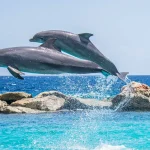November 27, 2018 — The Croatian fishing industry is trying to stay afloat amidst tightening regulations, a tough global market and more European Union-mandated restrictions in the works.
It would also help if Croats ate more fish, according to Robert Momić, Chairman of the Istrian Fishing Guild, who spoke with Glas Istre.
“Fishing has for centuries been the bedrock of life in coastal settlements in Istria,” Momić said. “It’s a part of their identity, something which draws excellence and recognition to the peninsula in the Adriatic and the Mediterranean [Seas].”
Despite this deep history, Croats themselves consume a comparatively small quantity of fish: about seven kilograms per capita annually, whereas other countries such as Portugal eat as much as 22 kilos.
Given the low demand at home, a majority of fish caught in Croatia’s chunk of the Adriatic packed into ice and exported — about 80 to 90 percent, according to Momić, most of it bound for Italy.
Fishing vessels are also held back by EU rules which Momić characterizes as short-sighted and lacking insight into the specific nature of local fisheries.
“It seems to me that the Union does not take differences into consideration, that it starts from global interests,” Momić said.
The EU’s Common Fisheries Policy sets quotas for member states limiting overfishing of what’s considered a “common resource.” The practice often irks both sides of a broad ecological and economic spectrum.
Regulations often draw the ire of local fishermen, who claim a one-size-fits-all approach cannot work in micro-locations with varying conditions and climates. Eco-conscious groups conversely often decry the rules as too-lenient, placating to big business groups to the detriment of dwindling fish stocks.
The European Parliament, for example, recently proposed lowering the maximum quota on blue fish from 60,000 to 40,000 tons, according to Morić, a reduction that’d make the maths on profitable fishing even tougher.
Croatia’s fishermen are already hamstrung by seasonal restrictions which cover about 80 percent of the Adriatic and take place in January, February and May. Lower quotas will only add to the pain, he added.
“Imagine 30 percent less work and fewer workers in industries that have already been minimized,” he said. “I don’t know the reason for this drastic cut which would bring us to our knees.”
Fishing of all kinds — from seines which dangle down from the surface to trawlers which scrape along the seabed — are met with illogical constrictions, according to Momić.
Trawlers, for example, cannot be dropped within three miles of the coast, giving an advantage to Italian fishermen who have a much larger, neater chunk of coast with fewer islands. Too often, Croatian fishing boats find themselves anchored ashore while their Italian counterparts bring up full nets.
The Adriatic Sea takes up only a small portion of the overall area of all Mediterranean waters but is generous sea in terms of actual catch, with up to one-fifth of the Mediterranean’s fish production coming from the Adriatic. Of that fifth, 40 percent comes from the Northern Adriatic.
Economics be damned, the fisherman’s life itself has become inextricably enmeshed into the Istrain identity and way of life. The northern Adriatic has a unique fishing culture recognizable by its its complexity, Momić added.
“There’s a tendency to forget and we cannot let this happen,” Momić said. “It would be detrimental to our identity, but also the general economy.”
For more on fishing in Croatia, check out our dedicated page.








